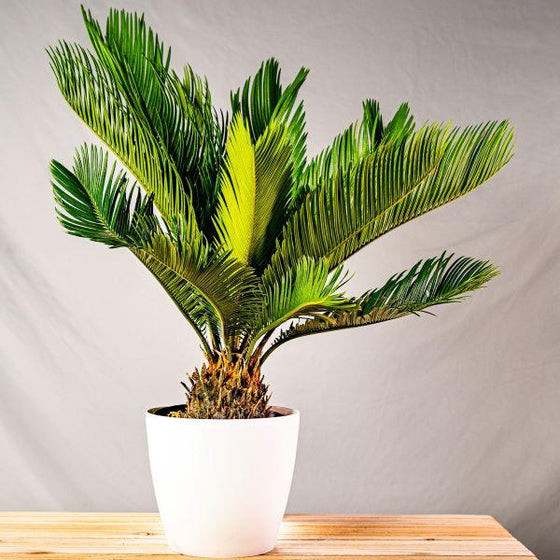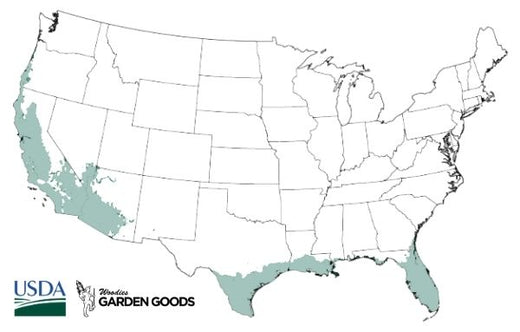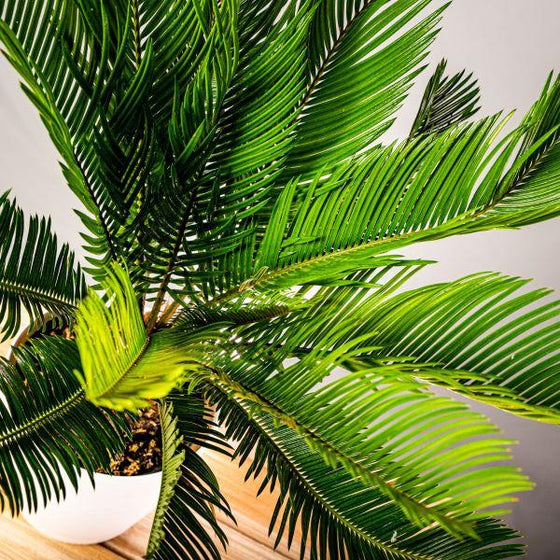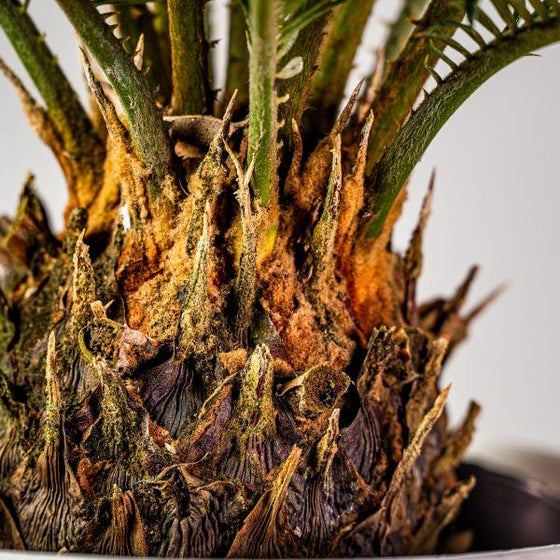
Images Depicted Range in Maturity & Container Size
Pots & Decorations Not Included Unless Otherwise Stated
Sago Palms for Sale Online
Although not a true palm, the Sago Palm (Cycas revoluta), offers a look into what life looked like on prehistoric Earth. These glossy, dark green cycads have been growing and thriving since dinosaurs roamed the Earth. As you can imagine, the plants are incredibly hardy houseplants, or can even be planted outdoors in full sun where hardy. The feathery foliage on Sago Palm Plant makes an excellent background plant for a corner indoors or an accent plant on an end table in the living room or dining room.
Easy to Care for Sago Palm Plant
Sago palm plant is classified by a large cylindrical trunk that does not branch and leaves that unfurl from a center rosette, usually falling as they grow old, leaving a crown of leaves at the top growth point of the plant. Sago Palm Plants are one type of cycad that have been around since dinosaurs roamed the Earth, and they have evolved little since then. Dark green, glossy, and smooth foliage is extremely symmetrical and geometric, making this a very attractive plant to view from above.
In containers, these plants typically will not flower. Outdoors, the sago palm produces a brown, upright inflorescence that, once pollinated, will produce small, seeds. Because of their solid green foliage, the Sago Palm plant will match virtually any space and color indoors or outdoors. Sago Palm is an incredibly slow-growing, low-maintenance plant. The most common problem that people encounter is giving them too much water; these plants are prone to rotting if the soil does not drain properly from the container or location they're planted in. Sago Palms are very low maintenance plants.
*Decorative containers shown are for display purposes only. All plants are shipped in black plastic nursery containers unless otherwise specified.

| Hardiness Zone: | 9-11 |
|---|---|
| Mature Height: | 30"-36" |
| Mature Width: | 30"-36" |
| Classification: | Green Foliage |
| Sunlight: | Fluorescent light to Full sun (if outdoors) |
| Habit: | Palm tree habit, unlikely to flower in containers |
| Flower Color: | Brown inflorescence |
| Foliage: | Dark green, glossy |
| Soil Condition: | Likes to stay dry |
| Water Requirements: | Likes to dry out between watering |
| Uses: | Hardy plant to keep indoors or outside |
Additional Information
History and introduction of Sago Palm:
Sago Palm is a very long lived plant that has survived since prehistoric times. The Sago Palm that are grown commercially stem from plants found in the Ryuku islands in Japan. Although commonly called Sago Palm, these plants are actually a type of cycad. Cycads are more closely related to conifers and gingkos than they are to true palms. These cycads have changed very little since their origin 200 million years ago. It is normal to see small pups forming either at the base of the trunk or near the foliage at the top of the plant. Alternately, once plants reach maturity, they can be bred to produce seeds and new plants. Sago Palms are dioecious, meaning that plants are either male or female, but not both. Female Sago Palms are pollinated by either the wind or flying insects, which carry pollen from the male plant. After pollination, female Sago Palms produce a small, round seed similar to a series of acorns in the center of the foliage. The seeds will change color, from a light yellow-tan to a deeper orange red, and the coverings around the seeds will start to open slightly. This is the signal that the Sago Palm seeds are ready to be separated and planted. Cycas revoluta is the Latin name for Sago Palms, which refers to their way of producing new fronds: in a revolution, or complete circle in the center of the plant.









